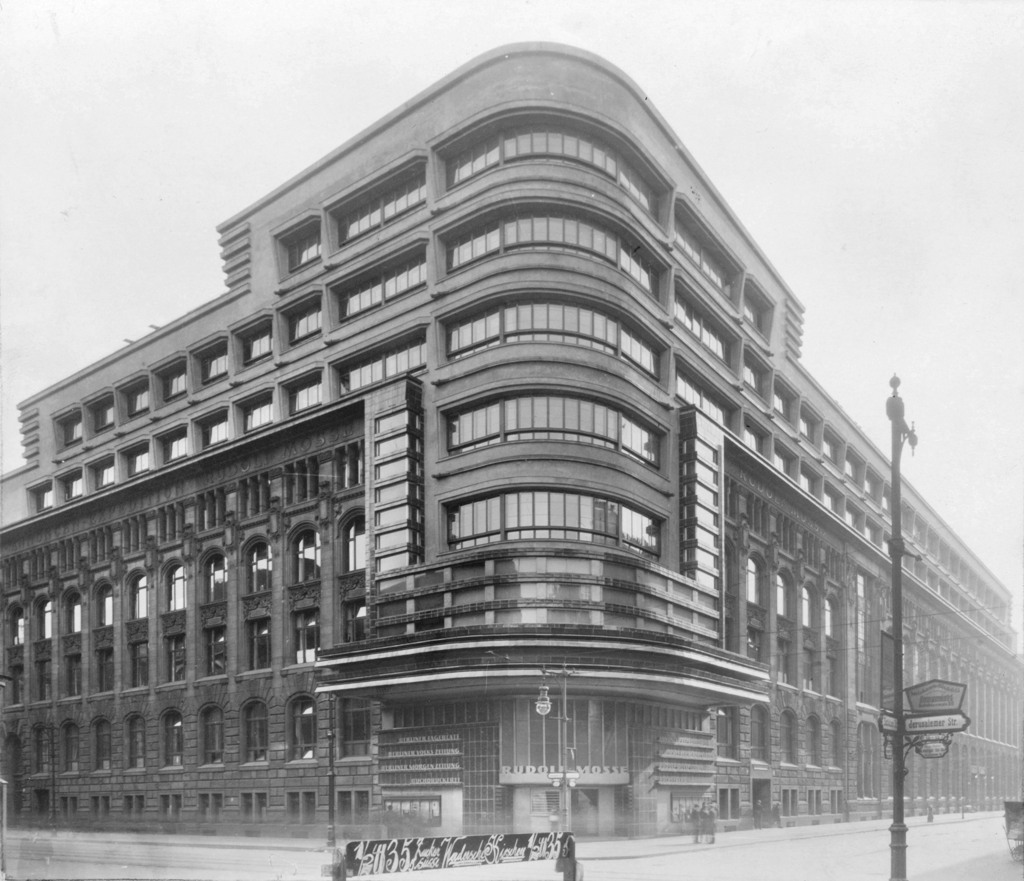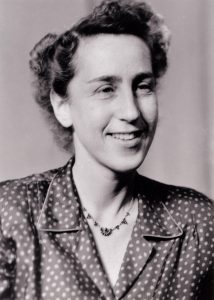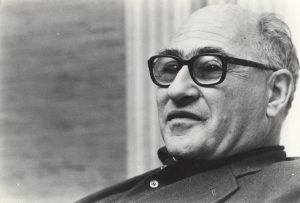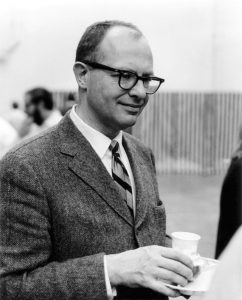



The Mosse Family
Contribution of the Mosse Foundation – c/o Roger Strauch, The Roda Group, Berkeley, CA

Rudolf Mosse’s business leadership and industry foresight created a phenomenally successful publishing and advertising enterprise in Germany from 1867 through early 1930’s. The enterprise published 130 newspapers and journals which included the Allgemeine Zeitung des Judentums and the Berliner Tageblatt (created in 1872), edited by Theodore Wolff. During his lifetime, Rudolf and his wife, Emilie engaged in numerous charitable and art related activities. Beneficiaries included educational and public institutions throughout Germany. Rudolf and Emilie were recognized with an honorary degree from the University of Heidelberg. They founded a home for children of impoverished families, the Emilie- und Rudolf Mosse-Stiftung. They opened a hospital in Graetz and established an insurance fund for all of Rudolf’s employees. The Mosse family were also recognized as leaders of the Berlin Jewish Reform Community. Located in Potsdamer Platz, the Mosse Palais erected between 1881-1885, housed the distinguished Mosse Art Collection. The building was destroyed in 1945 during an air raid and a new Mosse Palais was constructed in 1998, designed by US architect, Hans Strauch (HDS Architecture), a Mosse descendant by marriage.
Following the death of Rudolf in 1920, Hans Lachmann-Mosse assumed management of the Rudolf Mosse Company and continued the family’s philanthropy and patronage to the arts. Like most of the members of the Mosse family, Hans went into exile after the election of Adolf Hitler; and the Rudolf Mosse Company was taken over by the National Socialists and renamed the Rudolf Mosse Foundation on April 8, 1933.
From his first marriage, Hans Lachman-Mosse had three children, Rudolf, Hilde and George (formerly named Gerhard). Hans later married Carola Bock, (daughter of German writer, Alfred Bock), who had a child, Karl Strauch from a former marriage. Hans’ oldest son, Rudolf, had a daughter, Joy, who along with her mother, Jutta, are descendants of the Mosse Family residing in the United States. Hans’ other children, Hilde, George and step-child, Karl were exiled and emigrated to the United States. They became prominent representatives of the Mosse Family with extraordinary achievements in their respective fields, history, child psychiatry and particle physics.

Dr. Hilde L. Mosse, studied medicine at the University of Basel. Hilde immigrated to New York in 1938 where she lived and worked until her death in 1982. She spent 30 plus years addressing the issues associated with learning and psychiatric maladies of children. Hilde was well known in both Europe and North America for her clinical and published work on childhood depression, the effects of mass media on children, violent behavior in children and reading disabilities. In 1964, she returned to Germany as a Fulbright Professor in Child Psychiatry at the University of Marburg. She was a fellow of the American Psychiatric Association, the American Psychiatry Association, The American Orthopsychiatric Association and the New York Academy of Medicine.
While practicing child psychiatry in Harlem, New York, Hilde co-founded the Lafargue Clinic, the first children’s mental health clinic on the East Coast of the United States. Dr. Mosse published numerous articles on childhood behavioral disorders which appeared in American and German journals. Hilde’s most notable publication, The Complete Handbook of Children’s Reading Disorders, describes an interdisciplinary approach to diagnosis, treatment and prevention of reading disorders. In 1980, Dr. Mosse received the Watson Washburn Memorial Award for excellence in education by The Reading Reform Foundation in Houston, Texas for this published work. Dr. Mosse’s commitment to serving the economically disadvantaged and the emotionally troubled without regard to race, color or creed continues through the work of the Northside Center for Child Development in New York City (http://www.northsidecenter.org/v5/pages/support/2013.php). Roger Strauch, a Mosse descendant by marriage is a board member of Northside.

George Mosse became one of the most prominent historians of National Socialism. Following his studies at the University of Cambridge, England, George emigrated to the United States, and earned his Ph.D. from Harvard University in 1946. He went on to become the Bascom Professor of European History and Jewish Studies at the University of Wisconsin, Madison, WI. Beginning in 1969, he also held the Koebner Professorship of History at Hebrew University in Jerusalem.
In 2001, Gordon A. Craig, J. E. Wallace Sterling Professor of Humanities, Emeritus Stanford University, published an essay, “An Appreciation of George L. Mosse” where Dr. Craig describes George’s pursuit to understand the German-Jewish intellectual’s identity. As a historian, George felt he was called upon to explain the fate of the Jews in Germany and specifically, why it was that the more the Jews came to resemble the Germans the more they were rejected by them. The ideals of Bildung lived on but were fatefully challenged. George was a self described, “eternal emigrant”, a man who was driven to analyze the culture into which he was born and the forces that had compelled him to leave it. As a professor and historian, he provided students and apprentice historians advice and counseling above and beyond traditional teaching. George imparted upon them his own critical method and his openness and tolerance of diverse political, religious and social points of view.
George’s notable publications include: The Crisis of German Ideology, Intellectual Origins of the Third Reich (1964), Germans and Jews (1970), and Nationalism and Sexuality (1985). His monograph Toward the Final Solution: A History of German Racism (1978) investigates the racist stereotypes and anti Semitic images of the enemy. Masses and Man (1980) deals with mass hysteria and the fascist perceptions of reality.
George frequently returned to Berlin after the fall of the Berlin Wall in 1989. George oversaw the restituted property of the Mosse family and the preservation of the family’s legacy in the reunited Germany. During his visits to Berlin, George provided interviews where he discussed past and present Mosse undertakings, which were then published under the title I Remain Emigrant. Upon his death in 1999, George bequeathed his portion of the Mosse estate to the University of Wisconsin.
Shortly after his death, George’s autobiography, Confronting History, was published which provided a retrospective view into his private and professional life as a Jew and homosexual.

Dr. Karl Strauch was born in Giessen, Germany. His father, George Strauch, was a Lutheran minister and his mother, Carola was a divinity school graduate. George died of an infection only weeks after Karl was born. Carola later married Hans Lachmann-Mosse and the family were exiled from Germany in the mid-thirties and took residence in Paris where Karl earned his baccalaureate. In 1939, the family immigrated to Lafayette, California. Karl served in the US Navy from 1944 to 1946. He earned a degree in Chemistry and a PhD in Physics from the University of California at Berkeley in 1950. That year, he was elected to Harvard’s Society of Fellows and was appointed to the Harvard Faculty as Assistant Professor, became the George Vasmer Leverett Professor of Physics in 1975 and served as Chairman of the Harvard Physics Department from 1978-1982.
Karl chaired two committees that significantly impacted the policies and culture of Harvard. In 1975 the Strauch Committee recommended the merger of Harvard and Radcliffe’s admissions offices and the institution of an admissions policy of equal access for women. This recommendation was approved and instituted beginning with the Class of 1980. He also chaired the committee effort to build and establish the Science Center, the first multi-disciplinary science building in the College, and continued as the chair of the Faculty Executive Committee that oversaw the operation of the Science Center from its opening in 1972 until 1975. Karl and his wife, Maria, had 2 children, Roger and Hans Strauch. Roger and Hans are trustees of the Mosse Foundation. Hans is an architect in the Boston area (http://www.hdsarchitecture.com/home.html). Roger is a high tech venture capitalist in the San Francisco Bay Area (http://www.rodagroup.com/principals.html#ras).
In 1995, the Germanic Institutes of Humboldt University moved into the restored Mosse publishing house in Schützenstrasse / Jerusalemer Strasse. The prestigious publishing house was damaged in 1919, in the course of the German Novemberrevolution. The Storefront was restored in 1923 by Erich Mendelsohn, a friend of the Mosse family. The building heavily influenced the later Art Moderne, or Streamlining period of Art Deco style.
Dr. Klaus Scherpe and George Mosse met at the University of Wisconsin. Klaus Scherpe’s memories of George include a man who was proud of his German Jewish heritage and whose teachings and lectures were thought-provocating and highly engaging. His students loved his passion for teaching. In the mid-1990’s, Dr. Scherpe and George met again at Humboldt University to discuss the possibility of a series of sponsored lectures honoring the Mosse family and to feature the induction of several institutes in the rooms of the restored Mosse building. On May 14, 1997, the inauguration of the Berlin Mosse Lectures featured an exhibition of the Mosse heritage along with a speech by George Mosse, The Liberal Legacy and the Public of National Socialism. Since 1997, there have been over 230 events sponsored by the Berlin Mosse Lectures.
The estate papers of the Mosse family are currently preserved in the Leo Baeck Institute in New York. The Mosse Foundation resides in Berkeley and is represented by three trustees, high technology entrepreneur and investor, Roger Strauch (Berkeley, CA), architect, Hans Strauch (Cambridge, MA), and the attorney Henry Muller (New York, NY). The Mosse Foundation supports the Berlin Mosse Lectures at Humboldt University.
The Berlin Mosse Lectures have become a major intellectual institution in the German capital drawing large audiences and garnering national recognition. They preserve and reinvigorate a major German-Jewish tradition in today’s Germany.